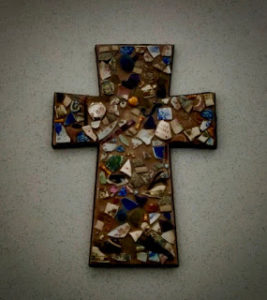
Mark 8:27-38
I have a small collection of crosses in my office, made of a variety of different kinds of material – wire, ceramic, clay, wood, glass. There is one that is a souvenir from Sacre Coeur Basilica in Paris; one is a souvenir from Mo-Ranch, the Presbyterian conference center in the Texas Hill Country. One was given to me by a man I met at a youth workcamp; he carved them out of purple heart wood and gave one to each of the chaperones. I have one that I made out of pieces of cut glass fused together. They are all beautiful.
To say the cross is beautiful – this is something no one would have said back in the first century. We have mostly forgotten that the cross was an instrument of torture, a gruesome form of capital punishment. The cross doesn’t have the same impact today as it used to. We wear crosses made of beautiful gold and silver, some with precious gems mounted on them. In our homes and in the church, we display crosses of smoothed, stained, and polished wood and shiny brass. They are beautiful; they are works of art.
The singer Madonna made the cross into a fashion craze back in the eighties. Every teenage girl of any faith, or no faith, wanted one. Someone told me, back then, about some girls shopping for crosses who asked the store clerk, “Do you have any of those kind with the little man on them?”
Well, we roll our eyes at these foolish girls who don’t know what a crucifix is, who don’t even know who that little man is or what he’s doing on the cross. How can they be so ignorant? In fact, we roll our eyes impatiently at Peter and the other disciples, too. What is the matter with them? How could they not understand what Jesus is saying to them? Take up your cross and follow me – don’t they know what he is all about?
About twenty years ago Ben Affleck and Matt Damon made a film called Dogma, a satire about the church. The Catholic League didn’t think it was funny; they declared it blasphemous. Affleck and Damon play two fallen angels who are trying to get back into heaven by exploiting a loophole in church law, or, dogma.
George Carlin plays a cardinal in New Jersey who decides the crucifix – you know, the cross with the little man on it – is just too much of a downer. So he decides to rebrand his church to create a more uplifting, feel-good message: he takes Jesus down off the cross and creates this new icon, a brand new Jesus, for his church – a cartoony-looking guy with a big toothy grin giving a thumbs up and a wink. Really. It’s called Buddy Christ.
The cardinal turns the entire message of the gospel upside down, because, you know, it’s depressing. Now it’s a message of good times, prosperity, living your best life now.
No more “take up your cross and follow me.” Replace that with “God just wants you to be happy.” It’s tempting, is it not?
I have to admit, it’s tempting. Because taking up my cross sounds like hard work, possibly quite painful.
I know it shouldn’t be such a problem, the idea of pain, because millions of people go to the gym every day to willingly inflict pain on themselves. But somehow it is a problem. Not too many people want to take up their crosses and follow him.
And I daresay that Peter and the other disciples felt that way too. None of them wanted to follow Jesus this way! Take up your cross? No one in their right mind would willingly submit to the cross of the Romans. It was ugly, it was brutal, it was the worst kind of death imaginable.
Can we blame Peter for taking Jesus aside to speak with him privately, not wanting to be seen as disrespectful toward him, but sincerely worried that Jesus was sending the wrong message? The cross! This would be seriously discouraging to any potential followers.
The message of the cross is a tough message. I don’t need to tell you that.
And they struggled with it, as we struggle with it; because we know, and they knew, the beautiful things that Jesus preached and taught and did. He healed. He demonstrated compassion. It was beautiful. And he did it not just for his friends, not just for people who were in his group, people who were like him. He had compassion for even the outcasts, even the “sinners.” His inclusivity was beautiful.
His disciples should have known this better than most, because among them were some of those “sinners.” Matthew, a tax collector, considered unclean and borderline acceptable by his own people due to the nature of his work. Yet Jesus called him, saying “follow me.” He was included; he was loved. It was great, wasn’t it?
Yes, they were bewildered; yes, they were continually surprised by the turns Jesus would take, the answers he would give to the Pharisees. They were surprised, no doubt, by the company he would keep. At every turn, they were surprised by him. But it was beautiful, wasn’t it? The things he did? So beautiful, in fact, they couldn’t see the inevitable path it would take toward the cross.
They chose to follow Jesus, I suppose, because they could do no other. Even now, at this moment when he draws a line in the sand saying, “On this side, the cross. If you want to follow me, come over here. Make up your minds.” And they still followed him.
I’m not sure they yet understood what he meant by that. Don’t we still struggle to understand what it means to take up our cross? What is your cross? What is my cross?
It isn’t just the sufferings of daily life, which we all have. We all know the sufferings of living in these mortal bodies with aches and pains and fatigue. And we know the emotional suffering that seems to be part and parcel of being in relationships with other people. These are just in the nature of human life on earth.
I think there is more meaning in the notion of taking up your cross and following Jesus. For his suffering, his sacrifice, was not without meaning or purpose.
Jesus drew a line in the sand that day when he told the disciples what it would be like to follow him. But there were, perhaps, other times when Jesus crossed over the lines that others had drawn, which tell us something more about what this means – to take up your cross.
He broke rules. He crossed lines that religion had drawn and went over to stand beside the lepers, the tax collectors, the gentiles. He crossed lines that the world had drawn when he spoke of overturning the order of things – the last shall be first and the first shall be last.
The world still draws these lines. And here is something that is as true today as it was then: the world does not smile on those who cross the lines.
To stand with the poor, the drug-addicted, the homeless, the refugees, the prisoners. To show compassion for the downtrodden, the least of these who are Jesus’ brothers and sisters.
To stand where Jesus stands. Take up your cross and follow him.
“If any want to become my followers,” Jesus says. This is the way you will go. You might not be in the popular crowd. You won’t join the others in scoffing at the dirty guy who lives under the bridge. You won’t remain silent while the others are condemning whole races or ethnic groups as criminals or condemning anyone because of their skin color or gender or religion or sexual orientation. You won’t , because you will recognize the humanity they share with you.
You, like Jesus, will be scorned for your actions, for doing the unpopular thing.
If any want to become my followers, Jesus says. You will separate yourself, stand apart, from those who are in it for self-gain – whether it be material profit or just being well-liked. You will push back against those who would put stumbling blocks before the least of God’s children – the weakest, the neediest, the most vulnerable.
This is your cross: to do justice, love mercy, walk humbly with your God.
It is beautiful, isn’t it?
